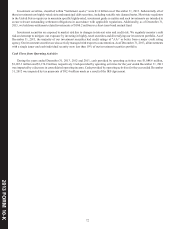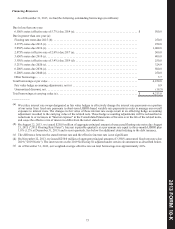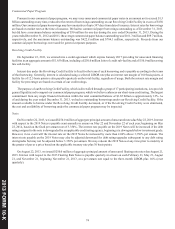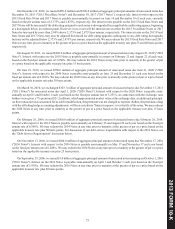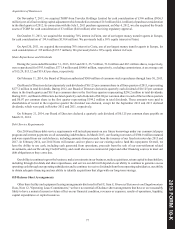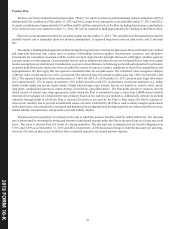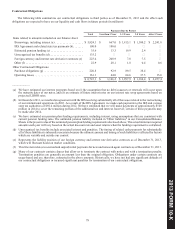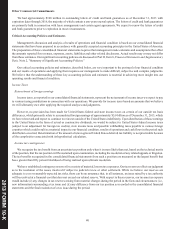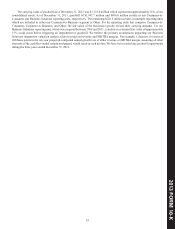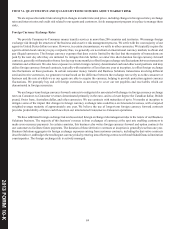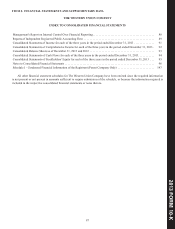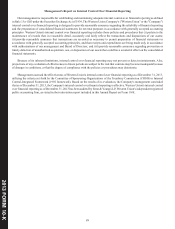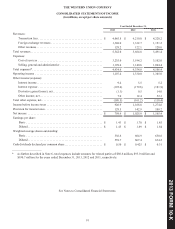Western Union 2013 Annual Report Download - page 192
Download and view the complete annual report
Please find page 192 of the 2013 Western Union annual report below. You can navigate through the pages in the report by either clicking on the pages listed below, or by using the keyword search tool below to find specific information within the annual report.
2013 FORM 10-K
82
The capitalization of initial payments for new and renewed agent contracts is subject to strict accounting policy criteria and
requires management judgment as to the amount to capitalize and the related period of benefit. Our accounting policy is to limit
the amount of capitalized costs for a given agent contract to the lesser of the estimated future cash flows from the contract or the
termination fees we would receive in the event of early termination of the contract. Additionally, the estimated undiscounted cash
flows associated with each asset requires us to make estimates and assumptions, including, among other things, revenue growth
rates, and operating margins based on our budgets and business plans.
Disruptions to contractual relationships, significant declines in cash flows or transaction volumes associated with contracts,
or other issues significantly impacting the future cash flows associated with the contract would cause us to evaluate the recoverability
of the asset. If an event described above occurs and causes us to determine that an asset has been impaired, that could result in an
impairment charge. The net carrying value of our other intangible assets as of December 31, 2013 was $833.8 million. We recorded
immaterial impairments related to other intangible assets for the year ended December 31, 2013 and did not record any impairment
during the years ended December 31, 2012 and 2011.
Goodwill
Goodwill represents the excess of purchase price over the fair value of tangible and other intangible assets acquired, less
liabilities assumed arising from business combinations. An impairment assessment of goodwill is conducted annually at the
reporting unit level. This assessment of goodwill is performed more frequently if events or changes in circumstances indicate that
the carrying value of the goodwill may not be recoverable. Reporting units are determined by the level at which management
reviews segment operating results. In some cases, that level is the operating segment and in others it is one level below the operating
segment.
Our impairment assessment begins with a qualitative assessment to determine whether it is more likely than not that the fair
value of a reporting unit is less than its carrying value. The initial qualitative assessment includes comparing the overall financial
performance of the reporting units against the planned results. Additionally, each reporting unit's fair value is assessed under certain
events and circumstances, including macroeconomic conditions, industry and market considerations, cost factors, and other relevant
entity-specific events. Periodically, we perform a quantitative assessment, as described below, for each of our reporting units,
regardless of the results of prior qualitative assessments.
If it is determined in the qualitative assessment that it is more likely than not that the fair value of a reporting unit is less than
its carrying value, then the standard two-step quantitative impairment test is performed. First, the fair value of the reporting unit
is calculated or determined using discounted cash flows and is compared to its carrying value. If the first step indicates the carrying
value exceeds the fair value of the reporting unit, then the second step is required. The second step is to determine the implied fair
value of a reporting unit's goodwill by allocating the determined fair value to all the reporting unit's assets and liabilities, including
any unrecognized intangible assets, as if the reporting unit had been acquired in a business combination. The remaining fair value
of the reporting unit, if any, is deemed to be the implied fair value of the goodwill and an impairment is recognized in an amount
equal to the excess of the carrying amount of goodwill above its implied fair value.
The determination of the reporting units and which reporting units to include in the qualitative assessment requires significant
judgment. Also, all of the assumptions used in the qualitative assessment require judgment. Additionally, for the quantitative
goodwill impairment test, we calculate the fair value of reporting units through discounted cash flow analyses which require us
to make estimates and assumptions including, among other items, revenue growth rates, operating margins, and capital expenditures
based on our budgets and business plans which take into account expected regulatory, marketplace, and other economic factors.
We could be required to evaluate the recoverability of goodwill if we experience disruptions to the business, unexpected
significant declines in operating results, a divestiture of a significant component of our business, or other triggering events. In
addition, as our business or the way we manage our business changes, our reporting units may also change. If an event described
above occurs and causes us to recognize a goodwill impairment charge, it would impact our reported earnings in the period such
charge occurs.


